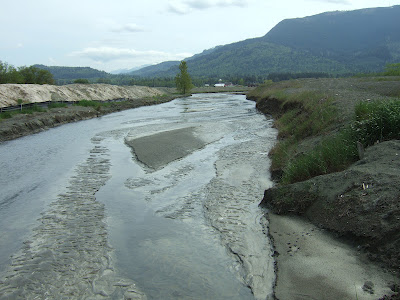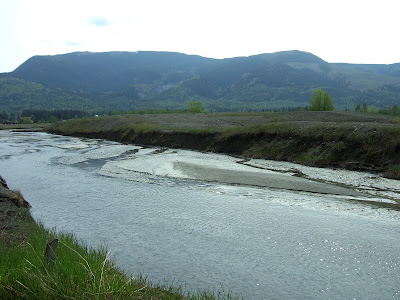Swift Creek with dredge sediment along bank
Yesterday was spent at the University of British Columbia at the 3rd Annual Asbestos Workshop: Scientific Issues Associated with the Swift Creek Landslide and it impact on the Sumas River Watershed System.
First a few notes: the Swift Creek Landslide is a huge problem for the local county government, Whatcom County, its a huge problem for the land owners in the vicinity of the slide and is a major threat to the most intensive agricultural land in Canada. Lots of angles to this problems and the information at the workshop leaves a great deal to digest.
Still Considering the Source: Another Year of Morphometry at the Swift Creek Landslide.
Scott Linneman, Prof. Dept. Geology, Western Washington University
Scott Linnemann started us off with the current conditions on the slide and the questions he has been working on regrading the slide activity and monitoring. Based on his work the overall slide movement rate of the entire slide mass is on the order of 3 meters per year. Check out the movie
landscapeobservatory/landslideCamTimeLapse
Preliminary sediment load and concentrations estimates from the Sumas River, April 2011 - April 2012. Chris Magirl, Research Hydrologist, U.S. Geological Survey, Tacoma WA.
Chris Magril presented the struggles of estimating sediment loads from the slide at downstream locations. Measurements estimate 16,000 metric tons per year passing down the Sumas River. However, he noted capturing the extreme peak loads of turbidity has been difficult. He has also measured pH in Swift Creek of 9.1 with one reading this past April reaching 9.47.
Attempts to quantify Sediment Loads in Swift Creek.
Paul Pittman, Earth Sci. Manager, Element Solutions, Bellingham
Paul Pittman presented his struggles with estimating sediment loads in the upper alluvial fan below the slide area. His work is an attempt to quantify the sediment loads both as turbid and sand, gravel and cobbles for sizing possible sediment capture basins. I visited his sampling site in April and observed the rocks bouncing through the constructed weir.
Sediment sampling weir at Swift Creek
Spatial & Temporal Changes in Water, Bed-Sediments, Suspended Sediments and Biofilms in the Swift Creek/Sumas River System.
Hans Schreier, and Julie Wilson, Faculty of Land & Food Systems, UBC.
This presentation had an intriguing observation that discharge on the Sumas River has been steadily increasing since the 1950s even though rainfall amounts have been very even and shown no increase. Schreier and Wilson also noted that the settling rate of the very fine sediment decreasing further downstream and that the pH decreases and Ca% decrease. We also learned about the challenges of testing biofilm development in a dynamic sediment environment and got an explanation of what those plate like features were that some us had observed in the creek.
How to measure Zeta-potential in sediment.
Beini Xu, Dept. Environmental Engineering, UBC
Beini Xu introduced us to zeta-potential in sediment. Presenting how polar like charges develop along the outer edges of
Beini Xu introduced us to zeta-potential and its role in brucite formation, one of the asbestos form minerals in the Swift Creek sediments. Understanding zeta potential is fundamental in understanding how and why the bructie develops along a curved spiral as well as an understanding of flocculation and brucite alteration.
Surface Characteristics of Asbestos fibers and Flocculation.
Les Lavkulich, & Hans Schreier. Profs. Faculty of Land & Food Systems, UBC
With our basics of zeta potential Les Lavkulich and Hans Schreier helped us through an understanding of the asbestos type fibers most common in the Swift Creek sediment. But more importantly some of the basics on controls for flocculation rates and noted that there are chemical/biologic controls as the sediment moves through different parts of the watershed.
Surface chemical properties of Chrysotile in the Sumas Watershed, before and after treatment with organic acids.
Emma Holmes, MSc. Candidate, Land & Food Systems, UBC
Emma Holmes gave us a bit of an overview of some of the mechanics at a molecular level that makes asbestos in the lungs such a nasty business. She also noted that chrysotile asbestos has a relatively short half life relative to amphibole asbestos 0.3 to 11 days compared to 500 days. After organic acid treatment, her studies indicated that the magnesium was heavily stripped from the outer layer of the brucite. Her work suggests that there may be some methods to reduce the toxicity of the fibers.
Organic acids and mixing zone
Progress in accelerating carbon sequestration within serpentine-rich materials.
Ian Power and Prof. Gregg Dipple, Dept. of Geological Sciences, UBC
Ian Power has been evaluating CO2 sequestration at mine tailing sites rich in serpentine-rich sediments. Again the focus is on the controlling factors. For example Are there ways that to design mine tailing piles that will absorb CO2 more rapidly? Kind of nice to think of the Swift Creek landslide as a great CO2 sink. He and coworkers estimate that the mine tailings at Clinton Creek, BC have absorbed 160,000 tons of CO2.
Comparison of methods assessing asbestos levels in soils at the Sumas Mountain Asbestos Site.
The sequestration of CO2 by the reaction Mg2SiO4 (Mg Olivine) (or one could you ather Magnesium silicates such as brucite) + 2CO2 ---> 2MgCO3 (magnesite) + SiO2. See Danae and others (2009) for an over view of site selection and Koukouzas and others (2009) for a bench study.
Bill Barrett , US-EPA Cincinnati and Julie Wroble,US_EPA, Seattle.
Julie Wroble noted that activity based asbestos air sampling is very expensive and discussed other sampling methods to equate soil asbestos levels to the risk of air route impacts to people. The testing was done on a residential property recently purchased by Whatcom County adjacent to the creek.
One of the testing sites used
All in all a very informative mix of science coming at all sorts of angles.
One final note, everyone was greatly appreciative of Tom Westergreen. Without Tom access to the site would have very limited and complicated. His cooperation and support of many of the study efforts by allowing easy access to the site has made progress on the challenge possible, but he also puts a human face on the challenges that the Swift Creek landslide and creek presents to the public. Part of the plus of this gathering was the discussions in the van on the way up to UBC and back that included lots of interetsing forest and Sumas Mountain history from Tom.




















































